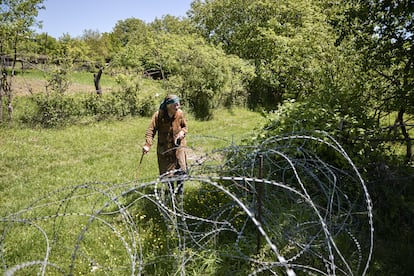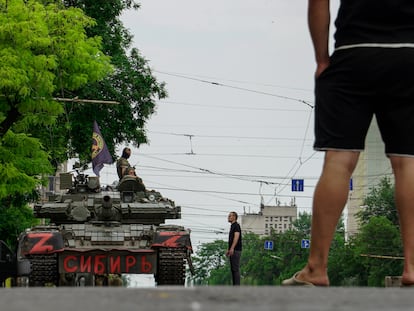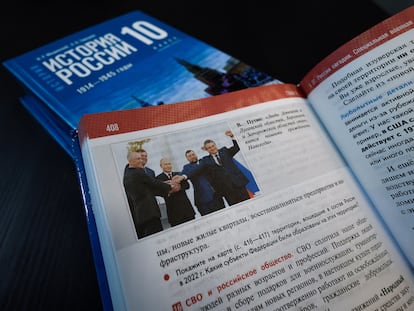The long agony of the Soviet Union: local identities, global conflicts
The implosion of the Soviet space, far from being a clean break with the past, has left cultural and political questions still unresolved

In the summer of 2014, refugees from the separatist territories of Donbas were being housed at a camp in Rostov-on-Don (Russia). Among them a grandmother rocked a baby while talking to this journalist: “Ukraine doesn’t let us speak our language,” she said in Russian. Little by little, however, the woman switched to Ukrainian and in this language she repeated the same message: “They don’t let us use our language, they don’t let us…” That grandmother, who switched seamlessly from one Slavic language to another without even realizing it, showed how fluid identities could become in the spaces of the former Soviet Union several decades after its disappearance.
When the USSR collapsed as an entity in 1991, many in Russia and the West believed they were witnessing a brief and relatively bloodless process of dissolution, whose protagonists were the 15 federated republics that made up the former union. But the clean break with the past that the leaders of the Soviet socialist republics of Russia, Ukraine, and Belarus proclaimed on a night in December that year was accompanied by more convoluted, more unforeseen and far-reaching developments. And it was then that the seeds of the current war against Ukraine were sown, although it was not until 2014 that Russia started the military action against its neighbor that was brought to a head in 2022.
Among Russian President Boris Yeltsin’s inner circle in the early 1990s, the idea prevailed that the independence of the federated republics of the USSR (especially the Central Asian ones) was going to free Russia from territories that leeched off its resources. Over time, however, the relief that Russia had cast off these freeloaders turned into resentment and frustration at the loss of land and influence.
In addition to 15 internationally recognized countries that were seeking their own identity, the collapse of the USSR left its “fringes” or territorial stripes, whose origin was in the political structure (like self-contained matrioshkas) of the Soviet State. These “fringes” were spaces with “frozen conflicts,” which were internationally unrecognized and, in theory, bequeathed to one or another of those new states that in fact had no control over them.
Initially, there were four unrecognized spaces, Abkhazia and South Ossetia, in Georgia; Transnistria in Moldova, and Nagorno-Karabakh in Azerbaijan, although the last case became part of the wider Armenia-Azerbaijan conflict. However, the security and survival of the others depended (and still depend) on Russia. Each of those territories had (and have) their historical and political arguments, and, in Abkhazia and South Ossetia, their own languages.
For years, Russia positioned itself as part of the solution to the “frozen conflicts” (as a participant in dialogues and mediations, as well as in peacekeeping missions with international legitimacy), but none of the rebel territories were ever reintegrated into the new post-Soviet states.
In 2008, the conflicts, which had been dormant for years, were reactivated after Georgia’s armed incursion against South Ossetian separatists. Following its military intervention, Russia unilaterally recognized South Ossetia and Abkhazia as states, thus blocking their reintegration into Georgia. In this way, the perspective of reintegration, which had been the goal pursued until then for all the “fringe” republics of the USSR, openly gave way to a new model that gave Moscow more opportunities to strengthen its influence over its neighbors.
Starting in 2014, Russia added others to the conflicts that were inherited from the USSR, as the fruit of its own destabilizing harvest. With Crimea annexed and chunks of the Ukrainian provinces of Donetsk, Luhansk, Kherson and Zaporizhzhia taken from Kyiv, Moscow is now trying to reconfigure the European map for its own gain.
Before February 24, 2022, the date that marks the beginning of a new stage, traveling through the problematic areas of the Soviet Union made it possible to see the development of those conflicts on the ground. The geographical distances between recognized and unrecognized territories had become political or military and travel had become labyrinthine.
In 2008, South Ossetia was isolated from Georgia and I remember a family from Tskhinvali (the capital of South Ossetia) that was never able to finish the renovation of their bathroom, because the bricklayers who did it lived in Tkviani (in the territory controlled by Georgia). Suddenly, in the 18 kilometers they traveled every day, an insurmountable barrier had appeared. On one side were the tiles and the workers; on the other were the tools.
In 2014, the mazes multiplied. Traveling legally from Kyiv to Crimea or to the pro-independence areas of Donbas required long detours, sometimes hundreds of kilometers, between places that were physically only dozens of kilometers apart. In contrast, Moscow’s military intervention also enabled risky shortcuts between Russia and Donbas, without customs or borders.
Starting in 2022, the labyrinths are much more extensive and fragment the spaces that, according to the failed globalizing vision of Mikhail Gorbachev (the last leader of the Soviet Union) should have been integrated into a European “Common Home” from the Pacific to the Atlantic. Today, going from Moscow to Western Europe, Russians have to stop in Turkey or Armenia and these paths could become even more tortuous in the future if drone attacks force air traffic to be moved from Moscow airports to others in more eastern locations in Russia.
In the troubled territories of the former USSR, Russia presents itself as the savior. Moscow distributes Russian passports to its inhabitants, pays their pensions, welcomes them into its educational and labor system, and maintains local budgets. However, in several of the “saved” territories, this journalist has spoken in confidence to influential members of the local communities: “We know that the Russians did not come to help us.” These words, spoken helplessly, sounded when it was too late to turn back the clock and return to negotiations that failed, partly also because the West did not want to consider the realities that survived the official dissolution of the USSR.
For years, traveling through the troubled spaces of the Soviet Union gave this journalist an opportunity to observe how the heirs of that disappeared country perceived themselves and the world around them. Now that Russia’s war against Ukraine and its political and diplomatic consequences make access to those territories even more difficult, it would be useful to remember the problems and choices that the citizens of the former USSR faced and continue to face.
This is an article written by Pilar Bonet in connection with her new book, 'Shipwrecked of the Empire' (Galaxia Gutenberg), which is published this Wednesday, September 6.
Sign up for our weekly newsletter to get more English-language news coverage from EL PAÍS USA Edition
Tu suscripción se está usando en otro dispositivo
¿Quieres añadir otro usuario a tu suscripción?
Si continúas leyendo en este dispositivo, no se podrá leer en el otro.
FlechaTu suscripción se está usando en otro dispositivo y solo puedes acceder a EL PAÍS desde un dispositivo a la vez.
Si quieres compartir tu cuenta, cambia tu suscripción a la modalidad Premium, así podrás añadir otro usuario. Cada uno accederá con su propia cuenta de email, lo que os permitirá personalizar vuestra experiencia en EL PAÍS.
¿Tienes una suscripción de empresa? Accede aquí para contratar más cuentas.
En el caso de no saber quién está usando tu cuenta, te recomendamos cambiar tu contraseña aquí.
Si decides continuar compartiendo tu cuenta, este mensaje se mostrará en tu dispositivo y en el de la otra persona que está usando tu cuenta de forma indefinida, afectando a tu experiencia de lectura. Puedes consultar aquí los términos y condiciones de la suscripción digital.
More information
Archived In
Últimas noticias
All the effects of gentrification in one corner of Mexico’s Colonia Roma
Palestinian reporter Youmna El Sayed: ‘My family told me I had to choose between being a journalist or a mother’
‘Sleepless City’: The light of cinema illuminates Madrid’s Cañada Real shantytown
The new language of the workplace: Knowing how to ask AI questions is more important than using it
Most viewed
- The low-cost creative revolution: How technology is making art accessible to everyone
- Christian Louboutin: ‘Young people don’t want to be like their parents. And if their parents wear sneakers, they’re going to look for something else’
- US sanctions against jailed cartel leader ‘El Marro’ highlight Mexico’s lack of control over its prisons
- Liset Menéndez de la Prida, neuroscientist: ‘It’s not normal to constantly seek pleasure; it’s important to be bored, to be calm’
- ‘El Limones’ and the growing union disguise of Mexican organized crime











































